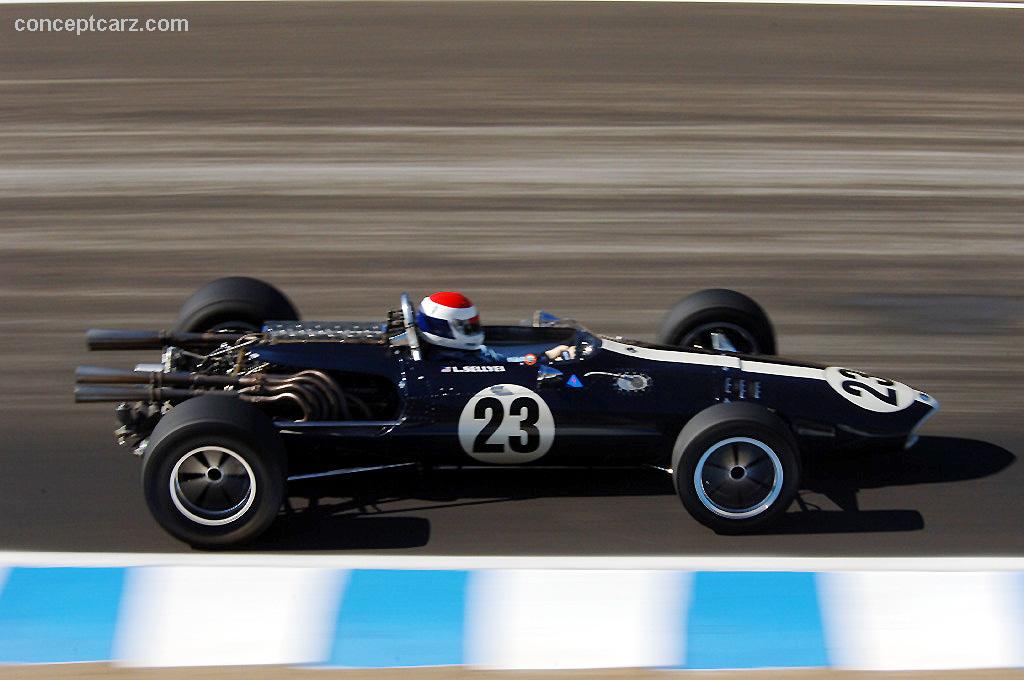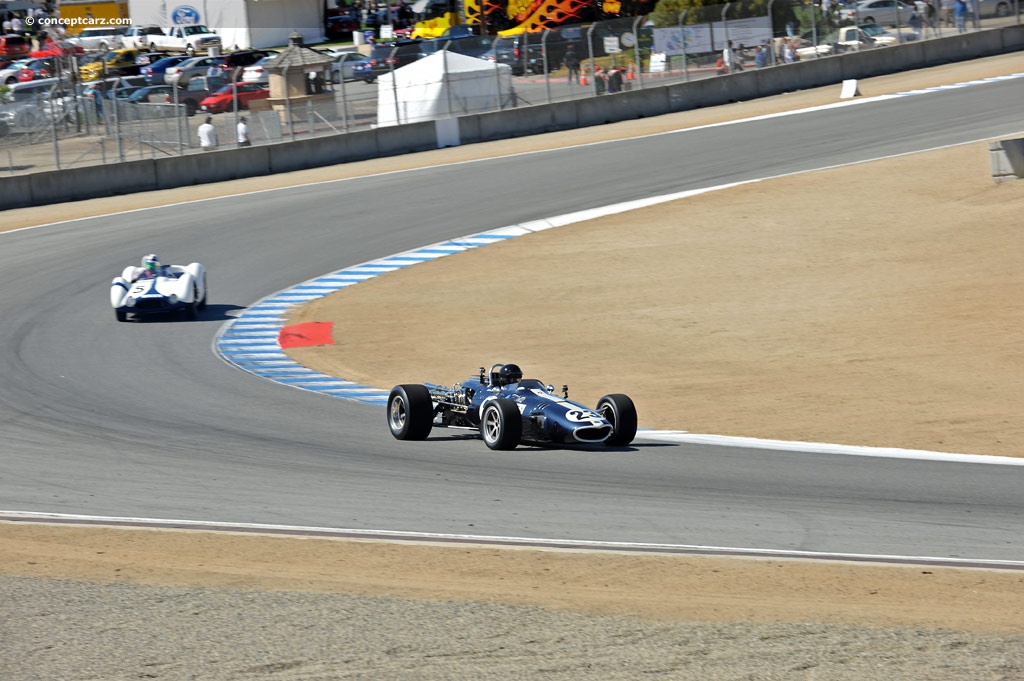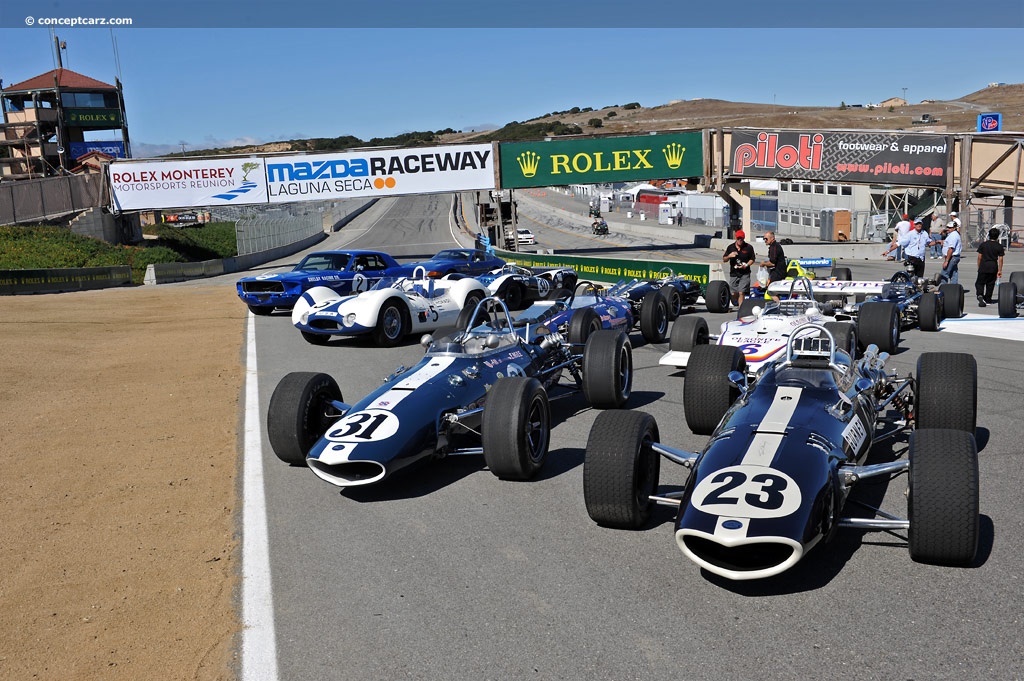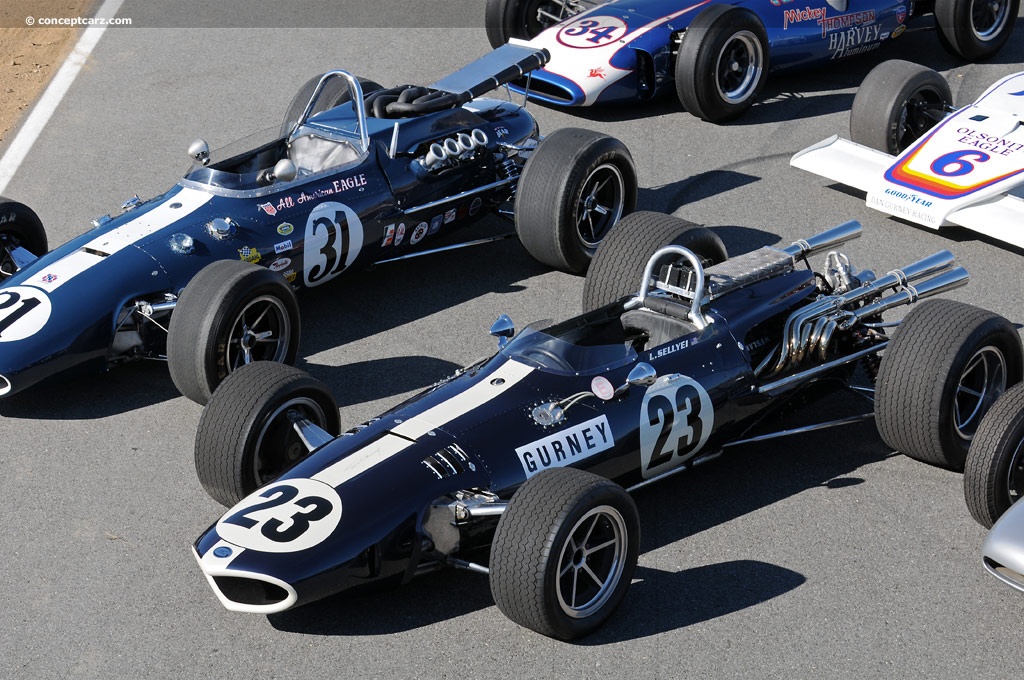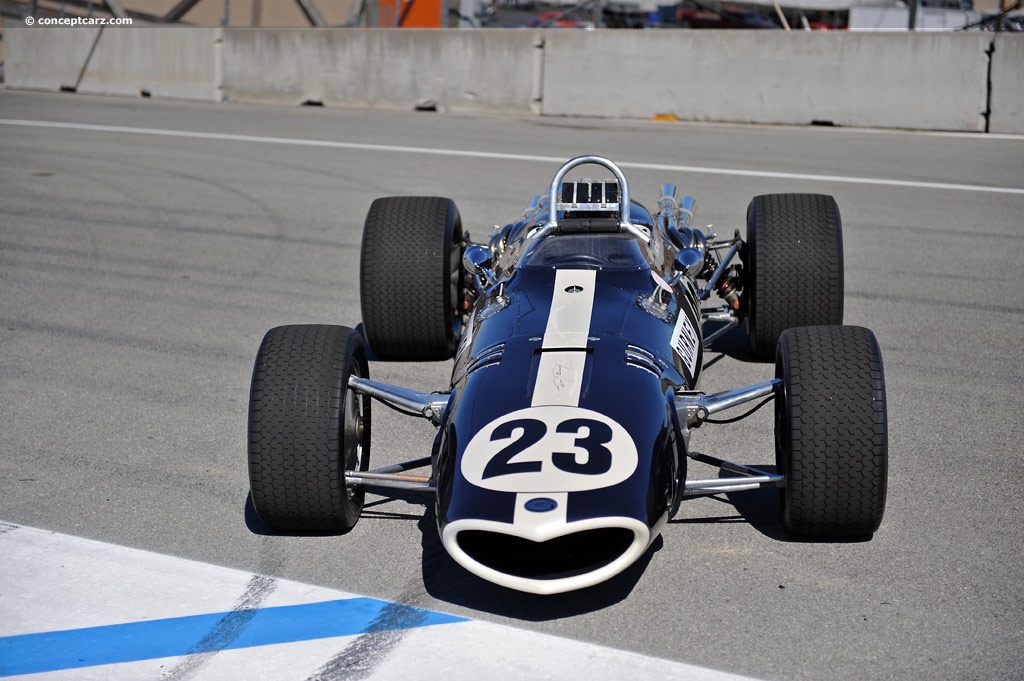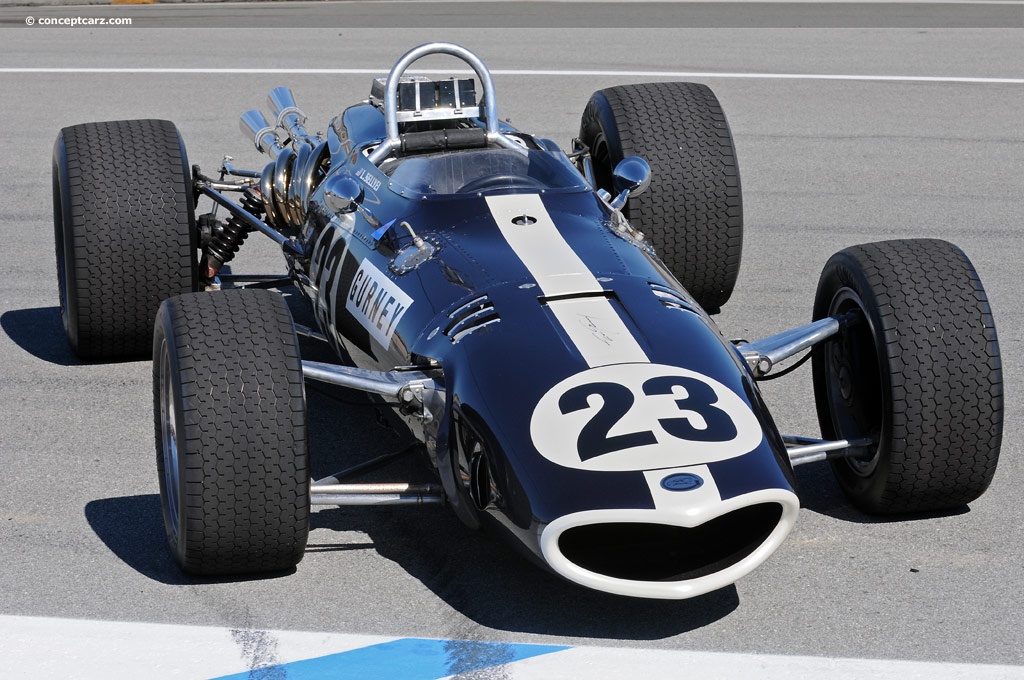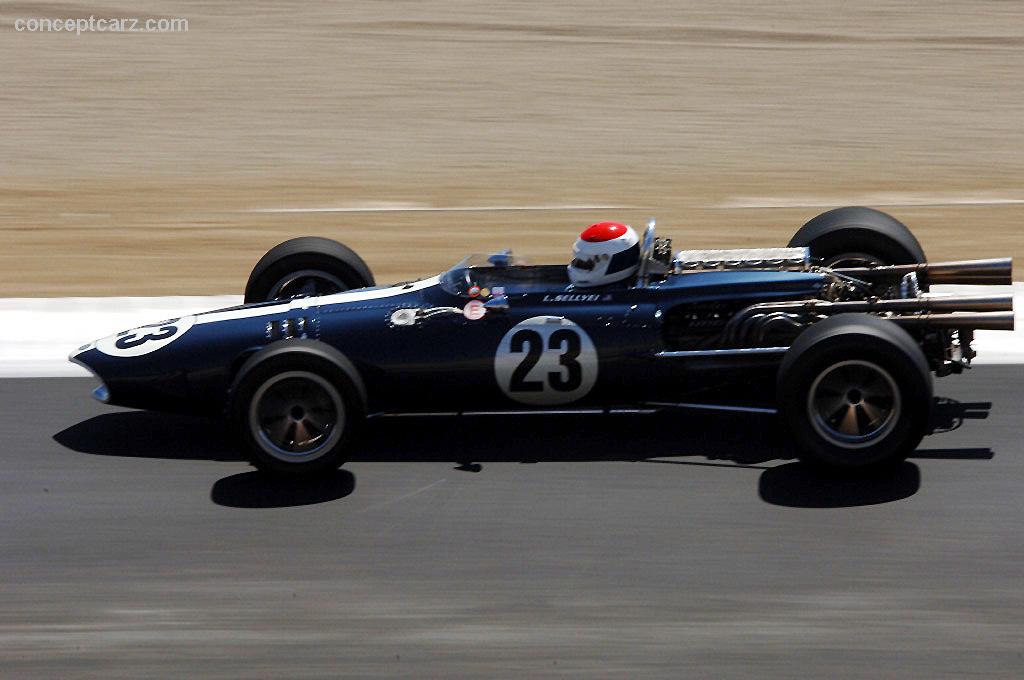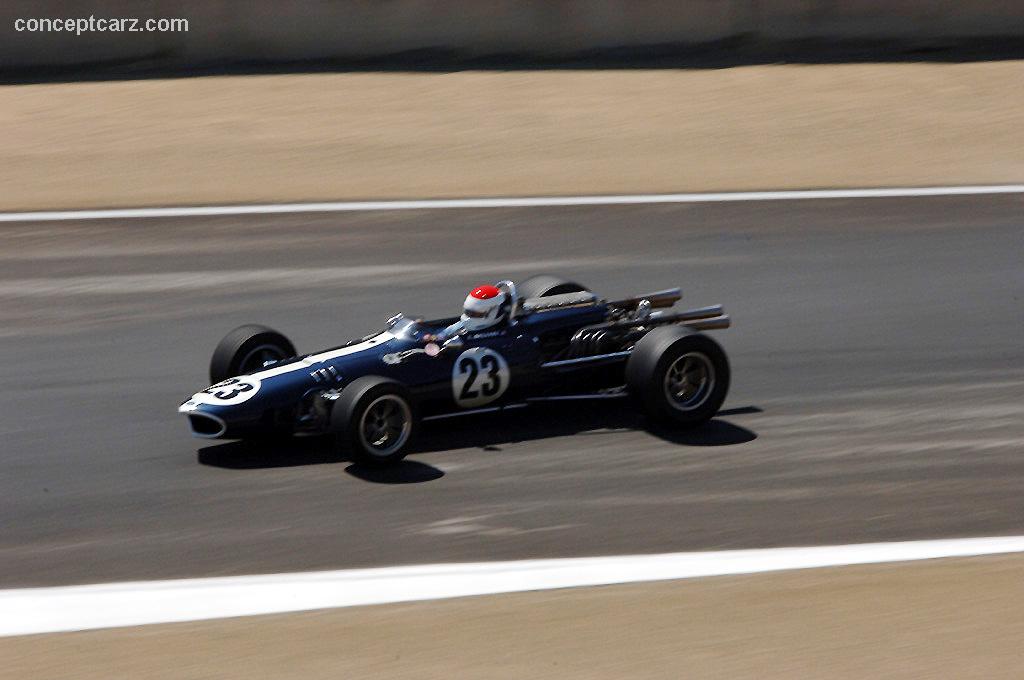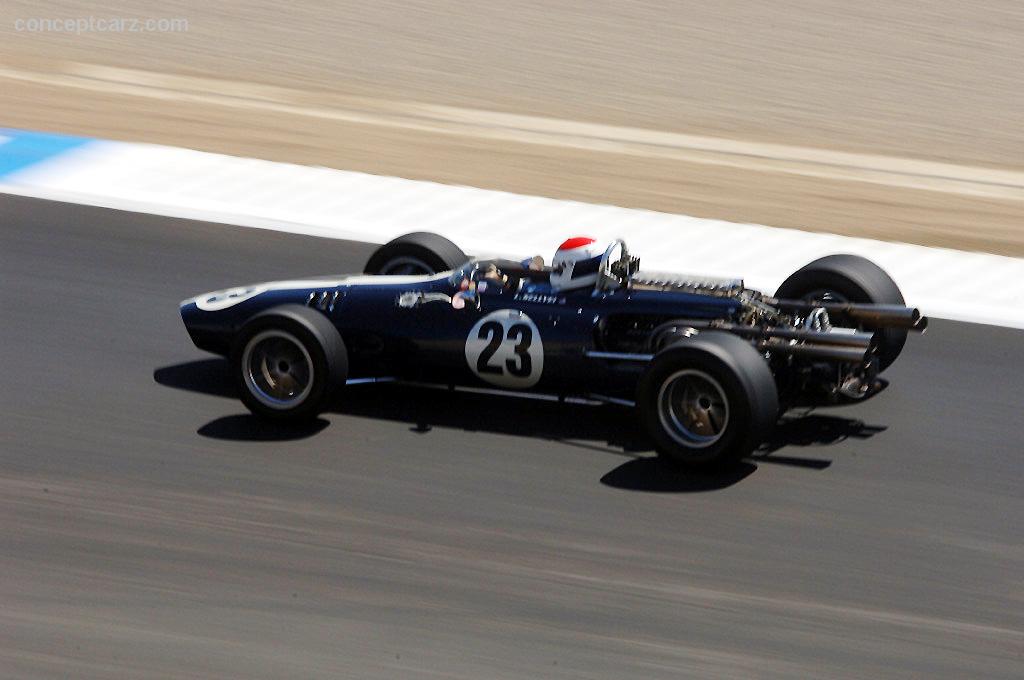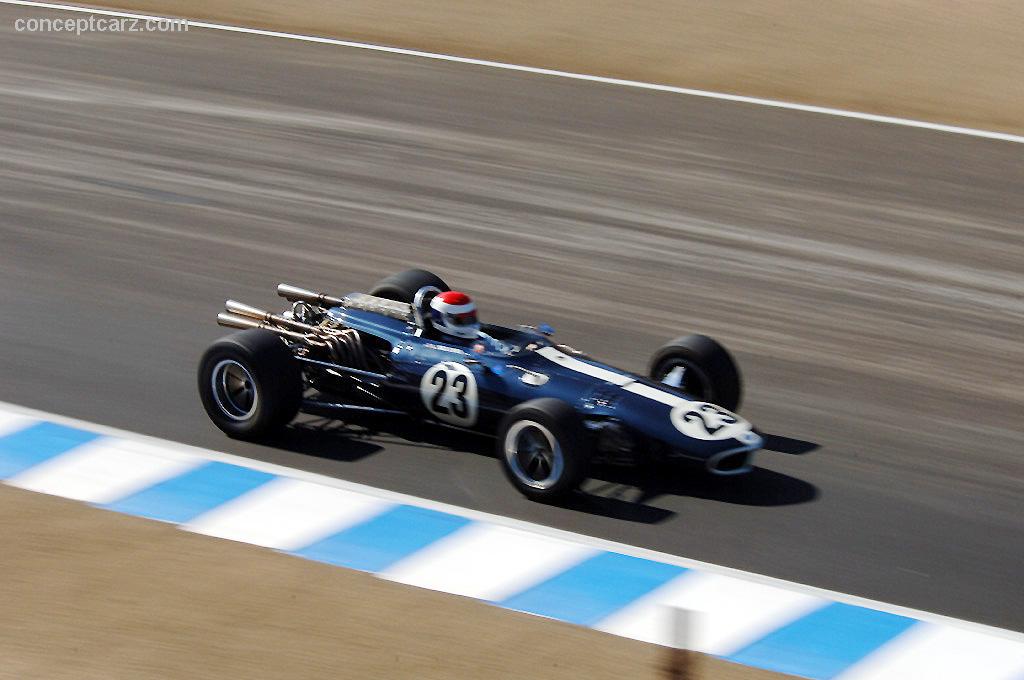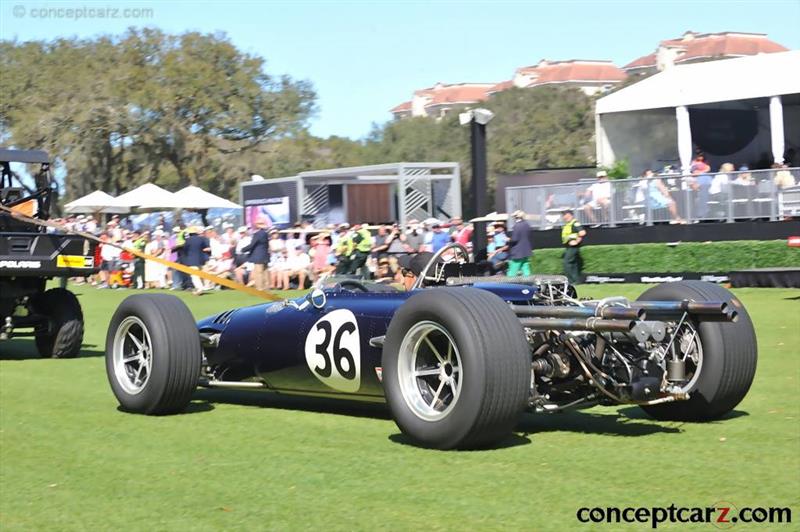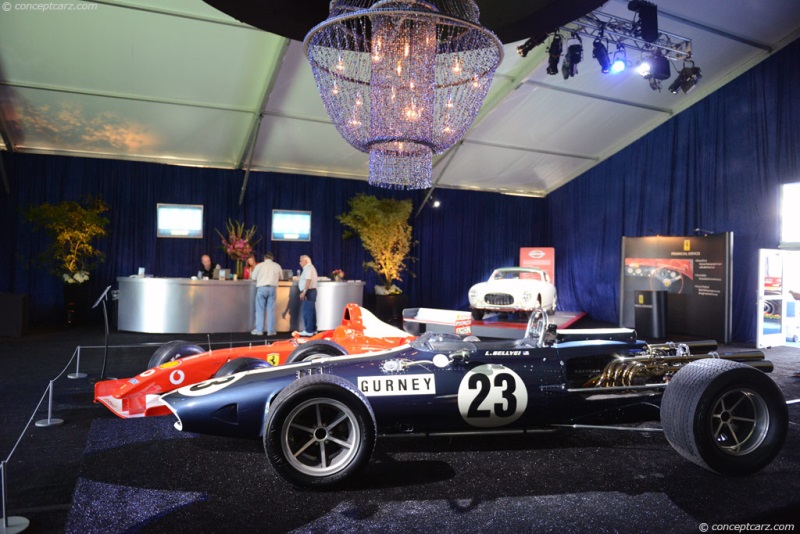Image credit: © conceptcarz.com (Reproduction Or reuse prohibited).
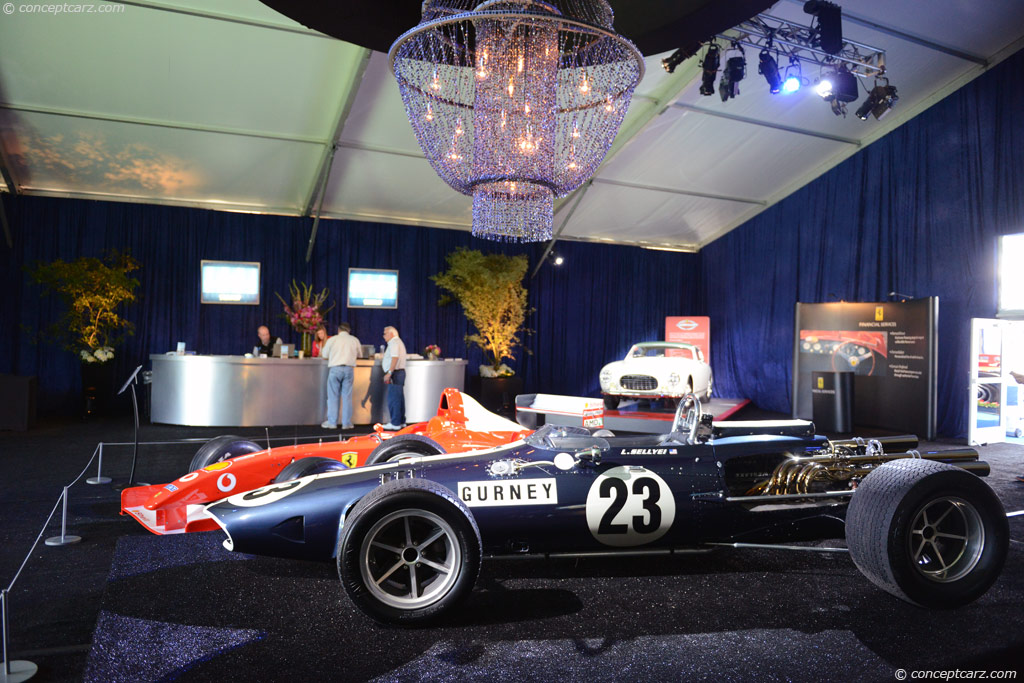
Dan Gurney began his Formula 1 career in 1959 driving for Scuderia Ferrari. In his first four races, he was able to achieve two podiums. This was followed by a miserable 1960 season, driving a BR P48 for Owen Racing Organization. So he joined Porsche's Grand Prix effort. At the 1962 French Grand Prix at Rouen, Guren drove the newly introduced 804 to his first World Championship victory and captured the first Formula 1 win for Porsche.
At the end of the season, Porsche withdrew from Grand Prix competition, leaving Brabham without a job. So Jack Brabham hired Gurney to become a part of his Brabham Racing organization. Between 1963 and 1965, Gurney captured two wins and 10 podium finishes for Brabham including the manufacturer's first World Championship win.
One of the individuals Dan Gurney would meet during his racing career would be Carroll Shelby. The two met as early as 1962, and discussions often led to the idea of building an American Formula 1 car. In 1965, Shelby convinced Goodyear to sponsor a new USAC team led by Dan Gurney. Gurney's team was called the All American Racers and based out of an industrial building in Santa Ana, California.
The newly formed AAR's initial focus was on building an Indy 500 contender. But since no US car and driver combination had ever won a major European Grand Prix since Jimmy Murphy's Duesenberg took the French Grand Prix in 1921, the team was compelled to follow their Formula 1 ambition. In 1965, Gurney began work on his first single-seat racing cars, which he dubbed the Eagles. The Eagle MK1 and Eagle MKII were designed in parallel, with the MK1 intended for Formula 1 competition while the MKII was built to compete in the USAC circuit.
Len Terry helped design and build the Indy Grand Prix car. His resume included work on the Indy 500-winning Lotus 38. His design for the AAR car was a full-length riveted aluminum monocoque chassis fitted with a beak nose which had been inspired by the Eagle name. Upon completion, the car was painted in a patriotic blue and white livery.
With a fully modern and advanced chassis, the team now needed an equally impressive power plant. They turned to Aubrey Woods who informed them of a three-liter V-12 that he had been developing with the Weslake Company in Rye, Sussex, England.
The Gurney-Weslake V-12 engine had a four-valve head and developed 410 horsepower at 10,200 RPM. The compact engine weighed just 365 lbs. It was also remarkably flexible, with a full-throttle power curve that began as low as 6,000 RPM.
After development and testing had been completed, the first AAR Eagle MK I, AAR-101, made its racing debut at the Belgian Grand Prix at Spa.
AAR-102
The second Formula 1 chassis built by the AAR team was the Eagle MK I chassis number AAR-102. It was the first example to race with the Aubrey-Woods-developed Gurney Weslake V12. It would make its racing debut in September of 1966 at the Italian Grand Prix at Monza, the seventh round of the World Championship. Driving duties were given to Dan Gurney. During practice, the car suffered from fuel feed problems and would have to start the race from the back of the grid. It wore race number 30 and would complete just seven laps before high oil temperatures ended its first Grand Prix attempt.
The second race for AAR-102 was the US Grand Prix at Watkins Glen in October. Though it initially performed well during practice, it was eventually sidelined with low oil pressure and a cracked fuel cell. For the race, Gurney wore number 15 and ran as high as 8th before oil leaked onto the clutch, causing it to slip and ending its second Grand Prix attempt.
The final event of the 1966 season was the Grand Prix of Mexico. This time, Bob Bondurant was behind the wheel of AAR-102 while Gurney raced AAR-101 with its Coventry Climax-powered engine. Once again, AAR-102 encountered trouble with the fuel delivery and was forced out of the race. Gurney and AAR-102, however, would finish the race in 5th place.
On the off-season, the team worked on resolving the various fuel and oil problems that had plagued the AAR-102.
The 1967 racing season began at Brands Hatch International Race of Champions on March 12th. It was a non-championship race that attracted all of the major Formula 1 team. During qualifying, AAR-102 laid to rest any questions to the car's potential as it outpaced the competition by a full second. It even lowered the existing lap record by three seconds. Friday's practice session was also met with favorable results, as Gurney again set the fastest time and was rewarded with 100 bottles of champagne.
The race consisted of two 10-lap heats and the 40-lap main event. Gurney drove AAR-102 to 1st place in the first heat. Gurney won the second heat followed by another Eagle car driven by Richie Ginther (AAR-103). During the main event, Gurney took an early lead and secured a victory over Lorenzo Bandini's Ferrari and Jo Siffert's Cooper-Maserati. This was an impressive accomplishment from AAR-102 considering it suffered from low oil pressure and a smoking engine.
After its victory at Brands Hatch, AAR-102 competed at Monaco, the second round of the 1967 World Championship. Gurney would fail to finish with AAR-103 due to fuel pump issues. Richie Ginther was unable to qualify with AAR-102.
In June, Dan Gurney won both the 24 Hours of LeMans with Ford's MK IV GT40 and the Belgian Grand Prix at Spa with AAR-104, both were milestones for an American driver. This made him only the second driver in history to win a Grand Prix in a car of his own design.
With the 1967 season coming to a close, the team hired Bruce McLaren for three races while his own cars were still being completed. At the French Grand Prix, he qualified well but was forced to retire due to mechanical issues. At the British Grand Prix at Silverstone, McLaren drove AAR-102 to 7th place until a connecting rod broke. The final Formula 1 outing for the car was at the German Grand Prix at Nurburgring. It was in 5th place when it went airborne, bottomed out, and broke the oil scavenge pipe.
After the 1967 season, Gurney decided to split with Weslake. AAR turned its focus on building Indy Cars for USAC events.
AAR-102 was sold in March of 1968 to the Swiss racing team Scuderia Filipinetti. The car was delivered with an underpowered four-cylinder Coventry Climax engine. Filipinetti tried to convince AAR to sell him one of the 23-cylinder Weslake engines but was unsuccessful. The Filipinetti team's driver, Herbert Muller, suggested that a 12-cylinder BRM engine be installed. In the end, Filipinetti became disillusioned with the project and lost the motivation to commit any more energy or time to the Formula 1 program.
Muller would use the Eagle (which had now been painted red with a single white stripe) in local events. After a few racing in 1968, the Eagle retired from racing and resided in the Filipinetti museum for 15 years.
In 1983, AAR-102 was sold to Martin Johnson of Lower Braithwaite Hall, Newby Bridge, England. A short time later, it was advertised for sale in Motor Sport. At the time, it was still finished in its Scuderia Filipinetti livery, had a Coventry Climax engine, and the original Monaco nose from 1967.
The car was purchased by Canadian collector Girvan Patterson. In April of 1984, AAR-102 was airfreighted across the Atlantic and stored at Mr. Patterson's property in Ontario. On October 12th of 1989, it was sold to Miles C. Collier and joined the CH Motor Cars collection in Naples, Florida. At the time, Mr. Collier already owned another Eagle MK 1 (AAR-104, the 1967 Belgian Grand Prix winner) and had acquired an impressive collection of spare components from AAR's remaining supply.
Between 1989 and 1992, AAR-102 was given a restoration to its 1967 Brands hatch configuration, complete with a proper Gurney-Weslake V-12 engine, number AAR 12-1-04.
After the restoration was complete, the car participated in the 1995 Goodwood Festival of Speed, where Dan Gurney drove it up the hill. In 1997, Mr. Collier sold AAR-102 to Mark Leonard of Grand Prix Classics who, in turn, sold it to William Zeiring of Talent, Oregon.
In 2003, the car entered its current owner's collection. The new owner obtained an FIA Historic Vehicle Identity Passport and entrusted AAR-102 to Intrepid Motorcar Co. for mechanical attention.
Since that time, the car has participated in several vintage races all over the world.
AAR-102 had been built during the golden age of Formula 1 competition and before the invention of aerodynamic aids and corporate sponsorship. It was driven by many famous drivers of the era including Dan Gurney, Phil Hill, Richie Ginther, Bob Bondurant, and Bruce McLaren.
Dan Gurney would enjoy a very impressive racing career with 312 starts, 51 wins, 42 pole positions, and 47 podiums with more than 50 makes and 100 different models. He was the first driver to win races in all four major motor racing categories (Le Mans, NASCAR, Indy Car, and Formula 1).By Daniel Vaughan | Jan 2014
At the end of the season, Porsche withdrew from Grand Prix competition, leaving Brabham without a job. So Jack Brabham hired Gurney to become a part of his Brabham Racing organization. Between 1963 and 1965, Gurney captured two wins and 10 podium finishes for Brabham including the manufacturer's first World Championship win.
One of the individuals Dan Gurney would meet during his racing career would be Carroll Shelby. The two met as early as 1962, and discussions often led to the idea of building an American Formula 1 car. In 1965, Shelby convinced Goodyear to sponsor a new USAC team led by Dan Gurney. Gurney's team was called the All American Racers and based out of an industrial building in Santa Ana, California.
The newly formed AAR's initial focus was on building an Indy 500 contender. But since no US car and driver combination had ever won a major European Grand Prix since Jimmy Murphy's Duesenberg took the French Grand Prix in 1921, the team was compelled to follow their Formula 1 ambition. In 1965, Gurney began work on his first single-seat racing cars, which he dubbed the Eagles. The Eagle MK1 and Eagle MKII were designed in parallel, with the MK1 intended for Formula 1 competition while the MKII was built to compete in the USAC circuit.
Len Terry helped design and build the Indy Grand Prix car. His resume included work on the Indy 500-winning Lotus 38. His design for the AAR car was a full-length riveted aluminum monocoque chassis fitted with a beak nose which had been inspired by the Eagle name. Upon completion, the car was painted in a patriotic blue and white livery.
With a fully modern and advanced chassis, the team now needed an equally impressive power plant. They turned to Aubrey Woods who informed them of a three-liter V-12 that he had been developing with the Weslake Company in Rye, Sussex, England.
The Gurney-Weslake V-12 engine had a four-valve head and developed 410 horsepower at 10,200 RPM. The compact engine weighed just 365 lbs. It was also remarkably flexible, with a full-throttle power curve that began as low as 6,000 RPM.
After development and testing had been completed, the first AAR Eagle MK I, AAR-101, made its racing debut at the Belgian Grand Prix at Spa.
AAR-102
The second Formula 1 chassis built by the AAR team was the Eagle MK I chassis number AAR-102. It was the first example to race with the Aubrey-Woods-developed Gurney Weslake V12. It would make its racing debut in September of 1966 at the Italian Grand Prix at Monza, the seventh round of the World Championship. Driving duties were given to Dan Gurney. During practice, the car suffered from fuel feed problems and would have to start the race from the back of the grid. It wore race number 30 and would complete just seven laps before high oil temperatures ended its first Grand Prix attempt.
The second race for AAR-102 was the US Grand Prix at Watkins Glen in October. Though it initially performed well during practice, it was eventually sidelined with low oil pressure and a cracked fuel cell. For the race, Gurney wore number 15 and ran as high as 8th before oil leaked onto the clutch, causing it to slip and ending its second Grand Prix attempt.
The final event of the 1966 season was the Grand Prix of Mexico. This time, Bob Bondurant was behind the wheel of AAR-102 while Gurney raced AAR-101 with its Coventry Climax-powered engine. Once again, AAR-102 encountered trouble with the fuel delivery and was forced out of the race. Gurney and AAR-102, however, would finish the race in 5th place.
On the off-season, the team worked on resolving the various fuel and oil problems that had plagued the AAR-102.
The 1967 racing season began at Brands Hatch International Race of Champions on March 12th. It was a non-championship race that attracted all of the major Formula 1 team. During qualifying, AAR-102 laid to rest any questions to the car's potential as it outpaced the competition by a full second. It even lowered the existing lap record by three seconds. Friday's practice session was also met with favorable results, as Gurney again set the fastest time and was rewarded with 100 bottles of champagne.
The race consisted of two 10-lap heats and the 40-lap main event. Gurney drove AAR-102 to 1st place in the first heat. Gurney won the second heat followed by another Eagle car driven by Richie Ginther (AAR-103). During the main event, Gurney took an early lead and secured a victory over Lorenzo Bandini's Ferrari and Jo Siffert's Cooper-Maserati. This was an impressive accomplishment from AAR-102 considering it suffered from low oil pressure and a smoking engine.
After its victory at Brands Hatch, AAR-102 competed at Monaco, the second round of the 1967 World Championship. Gurney would fail to finish with AAR-103 due to fuel pump issues. Richie Ginther was unable to qualify with AAR-102.
In June, Dan Gurney won both the 24 Hours of LeMans with Ford's MK IV GT40 and the Belgian Grand Prix at Spa with AAR-104, both were milestones for an American driver. This made him only the second driver in history to win a Grand Prix in a car of his own design.
With the 1967 season coming to a close, the team hired Bruce McLaren for three races while his own cars were still being completed. At the French Grand Prix, he qualified well but was forced to retire due to mechanical issues. At the British Grand Prix at Silverstone, McLaren drove AAR-102 to 7th place until a connecting rod broke. The final Formula 1 outing for the car was at the German Grand Prix at Nurburgring. It was in 5th place when it went airborne, bottomed out, and broke the oil scavenge pipe.
After the 1967 season, Gurney decided to split with Weslake. AAR turned its focus on building Indy Cars for USAC events.
AAR-102 was sold in March of 1968 to the Swiss racing team Scuderia Filipinetti. The car was delivered with an underpowered four-cylinder Coventry Climax engine. Filipinetti tried to convince AAR to sell him one of the 23-cylinder Weslake engines but was unsuccessful. The Filipinetti team's driver, Herbert Muller, suggested that a 12-cylinder BRM engine be installed. In the end, Filipinetti became disillusioned with the project and lost the motivation to commit any more energy or time to the Formula 1 program.
Muller would use the Eagle (which had now been painted red with a single white stripe) in local events. After a few racing in 1968, the Eagle retired from racing and resided in the Filipinetti museum for 15 years.
In 1983, AAR-102 was sold to Martin Johnson of Lower Braithwaite Hall, Newby Bridge, England. A short time later, it was advertised for sale in Motor Sport. At the time, it was still finished in its Scuderia Filipinetti livery, had a Coventry Climax engine, and the original Monaco nose from 1967.
The car was purchased by Canadian collector Girvan Patterson. In April of 1984, AAR-102 was airfreighted across the Atlantic and stored at Mr. Patterson's property in Ontario. On October 12th of 1989, it was sold to Miles C. Collier and joined the CH Motor Cars collection in Naples, Florida. At the time, Mr. Collier already owned another Eagle MK 1 (AAR-104, the 1967 Belgian Grand Prix winner) and had acquired an impressive collection of spare components from AAR's remaining supply.
Between 1989 and 1992, AAR-102 was given a restoration to its 1967 Brands hatch configuration, complete with a proper Gurney-Weslake V-12 engine, number AAR 12-1-04.
After the restoration was complete, the car participated in the 1995 Goodwood Festival of Speed, where Dan Gurney drove it up the hill. In 1997, Mr. Collier sold AAR-102 to Mark Leonard of Grand Prix Classics who, in turn, sold it to William Zeiring of Talent, Oregon.
In 2003, the car entered its current owner's collection. The new owner obtained an FIA Historic Vehicle Identity Passport and entrusted AAR-102 to Intrepid Motorcar Co. for mechanical attention.
Since that time, the car has participated in several vintage races all over the world.
AAR-102 had been built during the golden age of Formula 1 competition and before the invention of aerodynamic aids and corporate sponsorship. It was driven by many famous drivers of the era including Dan Gurney, Phil Hill, Richie Ginther, Bob Bondurant, and Bruce McLaren.
Dan Gurney would enjoy a very impressive racing career with 312 starts, 51 wins, 42 pole positions, and 47 podiums with more than 50 makes and 100 different models. He was the first driver to win races in all four major motor racing categories (Le Mans, NASCAR, Indy Car, and Formula 1).By Daniel Vaughan | Jan 2014
2013 Gooding and Company - Pebble Beach
Sale Price :
USD $3,740,000
Recent Sales of the AAR Eagle MK1
(Data based on Model Year 1966 sales)
| 1966 AAR Gurney-Weslake Eagle Mk 1 Chassis#: AAR-102 Sold for USD$3,740,000 2013 Gooding and Company - Pebble Beach |   |
AAR Eagle MK1s That Failed To Sell At Auction
1966 AAR Eagle MK1's that have appeared at auction but did not sell.
| Vehicle | Chassis | Event | High Bid | Est. Low | Est. High |
|---|---|---|---|---|---|
| 1966 AAR GURNEY EAGLE MK 1 | 101 | 2023 Gooding & Company : Amelia Island Auction | $3,000,000 | $4,000,000 |
Vehicles With Comparable Market Values
Similar sales to the $3,740,000 range.
| 1935 Bugatti Type 57 Atalante Chassis#:57252 Sold for $3,915,431 2024 Gooding & Company : London Auction | |
| 2010 Mercedes-Benz SLR McLaren Stirling Moss Chassis#:WDD1999761M900041 Sold for $3,643,376 2024 RM Sothebys : The Tegernsee Auction | |
| 1934 Duesenberg Model J Disappearing-Top Convertible Coupe Chassis#:2490 Sold for $3,745,000 2024 Gooding & Company : Pebble Beach |   |
| 1928 Mercedes-Benz 36/220 S-Type Four-Seated Sports Tourer Coachwork by Sindelfingen Chassis#:35985 Sold for $3,727,695 2024 Bonhams : Goodwood Festival of Speed | |
| 1972 Ferrari 365 GTS/4 Daytona Spider by Scaglietti Chassis#:15383 Sold for $3,701,561 2024 RM Sothebys : Monaco |   |
| 1930 Duesenberg Model J 'Disappearing Top' Convertible Coupe by Murphy Chassis#:2369 Sold for $3,855,000 2024 RM Sothebys : ModaMiami |   |
| 1972 FERRARI 365 GTB/4 DAYTONA SPIDER Chassis#:15277 Sold for $3,635,000 2024 Gooding : Amelia Island |  |
| 1972 LAMBORGHINI MIURA P400 SV Chassis#:5066 Sold for $3,580,000 2023 Gooding & Company : Pebble Beach |   |
| 1967 Ferrari 275 GTB/4 'Del Rio' by Scaglietti Chassis#:09831 Sold for $3,800,000 2023 RM Sothebys : Monterey |   |
| 1985 Ferrari 288 GTO Chassis#:ZFFPA16B000054809 Sold for $3,910,000 2023 Broad Arrow : Monterey Jet Center | |
| 1971 Lamborghini Miura P400 SV by Bertone Chassis#:4926 Sold for $3,580,000 2023 RM Sothebys : Arizona |   |
| 2022 Bugatti Chiron Super Sport 300+ Chassis#:VF9SW3V33NM795018 Sold for $3,718,748 2022 RM Sothebys : London | |
| 2015 Ferrari LaFerrari Chassis#:ZFF76ZFA2F0208568 Sold for $3,910,000 2022 Broad Arrow Auctions : Monterey Jet Center Auction | |
| 1992 Ferrari F40 Chassis#:ZFFMN34AXN0091097 Sold for $3,855,000 2022 RM Sothebys : Monterey |   |
| 2022 Porsche 911 'Sally Special' Chassis#:WP0AB2A91NS222257 Sold for $3,600,000 2022 RM Sothebys : Monterey |   |
| 1954 Maserati A6 GCS/53 Fiandri Spyder Chassis#:2071 Sold for $3,564,026 2022 Artcurial : Le Mans Classic | |
| 1989 Ferrari 640 Chassis#:109 Sold for $3,753,591 2022 RM Sothebys : Monaco Grimaldi Forum | |
| 2015 Ferrari LaFerrari Chassis#:ZFF76ZFA2F0211079 Sold for $3,662,500 2022 RM Sothebys : Amelia Island |   |
| 1985 Ferrari 288 GTO Chassis#:ZFFPA16B000055169 Sold for $3,916,476 2022 RM Sothebys : Paris | |
| 1996 Ferrari F50 Chassis#:ZFFTA46B000105053 Sold for $3,884,681 2022 RM Sothebys : Paris |
1966 AAR Eagle MK1
• Additional valuation insight and sales data• History
• Specifications
• Image gallery
• Other AAR Eagle MK1 model years
